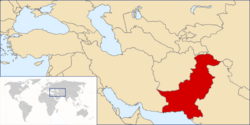Pakistan
| Islamic Republic of Pakistan اسلامی جمہوریہ پاکستان Islāmī Jomhuri-ye Pākistān |
||||||
|---|---|---|---|---|---|---|
|
||||||
| Motto: اتحاد، تنظيم، يقين محکم (Urdu) Ittehad, Tanzim, Yaqeen-e-Muhkam Unity, Discipline and Faith |
||||||
| Anthem: قومی ترانہ (Urdu) Qaumī Tarāna National Anthem |
||||||
| Capital | Islamabad | |||||
| Official language(s) | Urdu | |||||
| Demonym | Pakistani | |||||
| Government | Islamic Republic | |||||
| - | Prime Minister | Yousaf Raza Gillani | ||||
| - | Chairman of Senate | Muhammad Mian Soomro | ||||
| - | Speaker of House | Fahmida Mirza | ||||
| - | Chief Justice | Abdul Hameed Dogar | ||||
| Independence | from the British Empire | |||||
| - | Water (%) | 3.1 | ||||
| Population | ||||||
| - | 2008 estimate | 172,800,000 | ||||
| - | 1998 census | 132,352,279 | ||||
| - | Density | 206/km2 (53) 533.5/sq mi |
||||
| GDP (PPP) | 2007 estimate | |||||
| - | Total | 410,295,000,000 | ||||
| - | Per capita | 2,594 | ||||
| GDP (nominal) | 2007 estimate | |||||
| - | Total | 143,766,000,000 | ||||
| - | Per capita | 908 | ||||
| Currency | Rupee (PKR) |
|||||
| Time zone | PKT (UTC+5) | |||||
| - | Summer (DST) | PKST (UTC+6) | ||||
| Internet TLD | .pk | |||||
| Calling code | 92 | |||||
Pakistan (Urdu: پاکستان, Pākistān), officially the Islamic Republic of Pakistan (Urdu:اسلامی جمہوریہ پاکستان, Islāmī Jomhuri-ye Pākistān) is a nation in south-central Asia bordering Iran, Afghanistan, China, India and the Arabian Sea.
Ancient History
The Indus River, linking directly to the Arabian Sea, runs the length of the country almost directly in the center and feeds into the country India. Being within one of the few regions inhabiting and allowing the growth of ancient civilizations. Inevitably like most land on Earth it underwent repeated invasions from the Persians, Greeks, Scythians, Arabs (with a need to spread Islam), Afghans, and Turks.
5,000 years ago (about 2500 B.C.) the people of the region that constitutes Pakistan today is called the Indus River civilization or the Harappa culture. [1] These people developed extensively through trade with greater Mesopotamia, the land between the Tigris and Euphrates, and agricultural production with copper and bronze being in use, but not iron. [2]
The Harrapa culture (involved in a type of goddess worship) inevitably dies out through Indo-European migratory settlers and the human idea of extending their way of life rather then adopt or adapt to local habits or customs that were originally present. The late Harrapa and early iron periods blend with even more immigration from Indo-Europeans into modern day India, called the Vedic peoples, constructing an Indian religion embodied by the Vedas (sacred Indian/Hindu texts). [3]
Modern History
| ||||||||||||||||||||



